

HFA & SDGs - MDGs & DRR - Hyogo Framework - PreventionWeb.net. IISD Reporting Services. The third UN World Conference on Disaster Risk Reduction (WCDRR) took place from 14-18 March 2015 in Sendai, Japan.
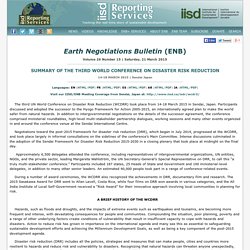
Participants discussed and adopted the successor to the Hyogo Framework for Action 2005-2015, an internationally agreed plan to make the world safer from natural hazards. In addition to intergovernmental negotiations on the details of the successor agreement, the conference comprised ministerial roundtables, high-level multi-stakeholder partnership dialogues, working sessions and many other events organized in and around the conference venue at the Sendai International Centre. Negotiations toward the post-2015 framework for disaster risk reduction (DRR), which began in July 2014, progressed at the WCDRR, and took place largely in informal consultations on the sidelines of the conference’s Main Committee. During a number of award ceremonies, the WCDRR also recognized the achievements in DRR, documentary film and research. The statements and webcasts can be viewed at: Proposed Goals and Targets. Biodiversity, marine and terrestrial ecosystems of local, regional, and global significance are inventoried, managed, and monitored to ensure the continuation of resilient and adaptive life support systems and to support sustainable development.
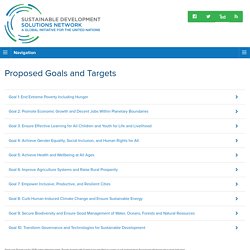
Water, oceans, forests, and other natural resources are managed sustainably and transparently to support inclusive economic and human development. Target 9a. Ensure resilient and productive ecosystems by adopting policies and legislation that address drivers of ecosystem degradation, and requiring individuals, businesses and governments to pay the social cost of pollution and use of environmental services. Titled. HFA & SDGs - MDGs & DRR - Hyogo Framework - PreventionWeb.net. World Humanitarian Summit. What is DRR and resilience? - Member website. No single group or organisation can address every aspect of DRR.
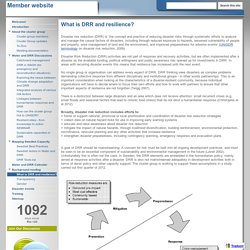
DRR thinking sees disasters as complex problems demanding collective response from different disciplinary and institutional groups - in other words partnerships. This is an important consideration when looking at the characteristics of a disaster-resilient community, because individual organisations will have to decide where to focus their own efforts and how to work with partners to ensure that other important aspects of resilience are not forgotten (Twigg 2007). There is a distinction between large disasters and an area which does not receive attention: small recurrent crises (e.g. small floods and seasonal factors that lead to chronic food stress) that do not elicit a humanitarian response (Christoplos et al 2012).
Broadly, disaster risk reduction includes efforts to: > foster or support national, provincial or local prioritisation and coordination of disaster risk reduction strategies. Disaster risk reduction. Disaster risk reduction (DRR) is a term used for reducing and preventing the effects of a disaster.
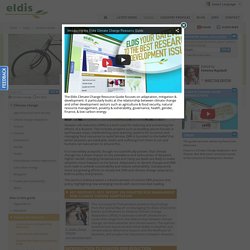
This includes projects such as building secure houses in earthquake areas, implementing early warning systems for tsunamis and managing food resources to avoid famine. DRR is founded on the belief that whilst disasters are inevitable, death and suffering from them is not and humans can take action to ensure this. It is now widely accepted, though not scientifically proven, that climate change has a direct impact on the prevalence and seriousness of disasters.
Higher rainfall, changing temperatures and rising sea levels are likely to make disasters more frequent in the future. Adaptation to climate change and DRR both seek to achieve sustainability and reduce vulnerability. The sections below present a critical overview of current DRR practice and policy, highlighting new emerging trends with recommended reading. Proposed Goals and Targets. Technology Transfer in the Climate Context: Who is responsible? Technology issues have always been at the forefront of the global climate change debate.
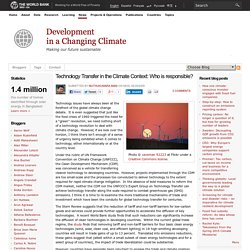
It is even suggested that just like the food crises of 1960 triggered the need for a “green” revolution, we need nothing short of a technology revolution to deal with climate change. However, if we look over the horizon, I think there isn’t enough of a sense of urgency being exhibited when it comes to technology, either internationally or at the country level. Under the rubric of UN Framework Convention on Climate Change (UNFCCC), the Clean Development Mechanism (CDM) was conceived as a vehicle for transferring cleaner technology to developing countries. However, projects implemented through the CDM are too small-scale and the processes too convoluted to deliver technology to the extent required for rapid climate change mitigation. However, countries have generally been reluctant to engage the trade and climate regimes for fear of one overwhelming the other.
Educational Materials. Documentation. Hazard Profile - Flood - Hazards - PreventionWeb.net. This hazard profile is an analysis of the mortality and economic loss risk for Flood Please see also: Flood Disaster Statistics Human Exposure Modelled number of people present in hazard zones that are thereby subject to potential losses.

Economic Exposure Modelled amout of GDP (Gross Domestic Product) present in hazard zones that are thereby subject to potential losses. Absolute economic exposure Relative economic exposure Source of data: 2009 Global Assessment Report Data displayed does not imply national endorsement ¹: In billions US$ Disclaimer: This analysis was conducted using global datasets, the resolution of which is not relevant for in-situ planning and should not be used for life and death decisions. Last data update: